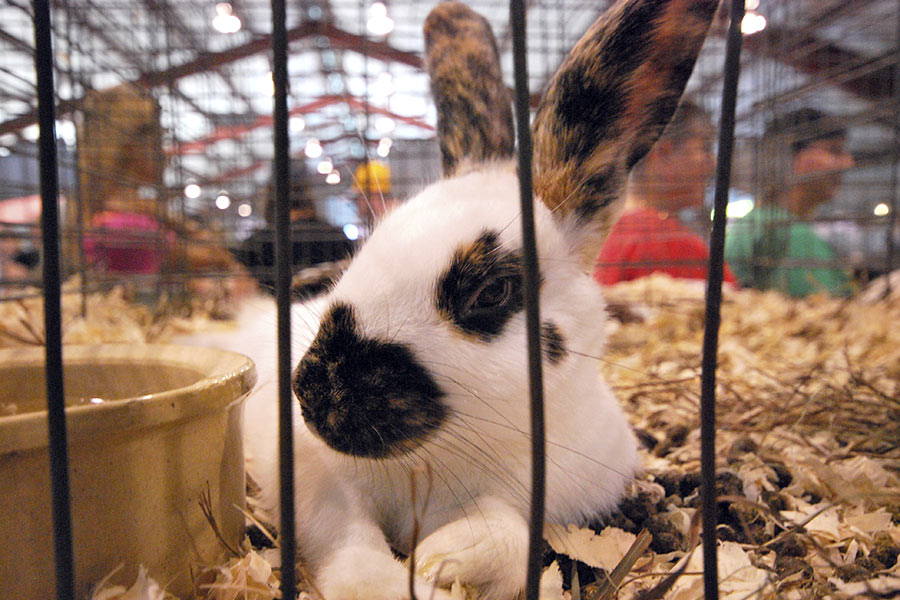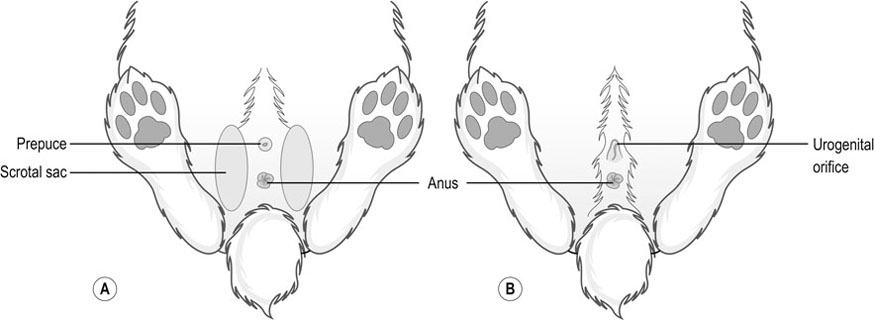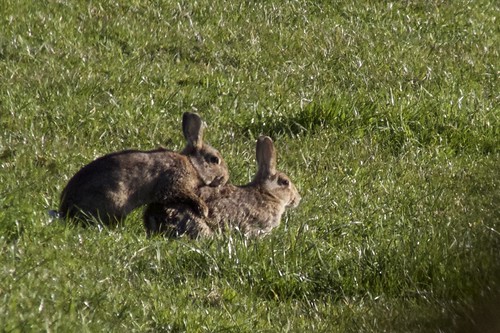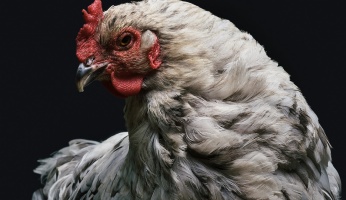How to Breed Rabbits: The Complete Guide
 How to Breed Rabbits: The Complete Guide
thegearhunt.com
How to Breed Rabbits: The Complete Guide
thegearhunt.com
Breeding any type of animal takes hard work and dedication to the animals to maintain their well being. With animals such as rabbits, they tend to take up less space, while requiring less food than larger animals you may think of for breeding. But don’t let that fool you, as breeding and raising rabbits won’t mean that there is less work involved in the process.
All you need to know about rabbit breeding
Rabbit breeding can be done for several reasons, not only are rabbits becoming more popular as pets, they are also popular amongst a special group, known widely as “Homesteaders”. Rabbits, whether we choose to agree with it or not, are a great sustainable food source. This is due to the fact that they reproduce rather quickly in comparison to chickens, cattle, or pigs. A side form their reproductive qualities, the meat that a rabbit can provide is one of the healthiest options for protein available. Their meat has more grams of protein per serving than that of chicken or turkey, not to mention that it also has way less fat per serving. Also when raising rabbits, you will see exactly how healthy rabbits truly are, as this is one animal that will never require you to administer antibiotics, making their meat also one of the purest available. Another great benefit to raising rabbits, their manure makes one of the best all natural fertilizer you could ask for to sustain the health of your garden or flower beds.
Besides for raising rabbits as a food source, some people will also breed and raise their own rabbits for show at local fairs. While others work hard to preserve the quality of bloodlines, that can sometimes unintentionally be tainted by people who breed rabbits without proper knowledge of what they are doing. Others want to breed rabbits purely as pets, spending much needed time with them in order to groom their behaviors before they become adopted by their forever families.

As you can see there a plenty of reasons people choose to breed and raise rabbits, one thing is for certain, there is a lot of work involved in doing so properly. Before taking on the task of breeding any animal, one should do the proper research to be sure they are willing to put in the hard work and commitment it takes to maintain the well being of the animal. You will see upon reading this guide that there is plenty of work to be done for breeding rabbits, starting with the care of the parents as well as the youngsters. Whatever your reasons for breeding your rabbits, before selecting the breed, do a little investigating to be sure the breed you have selected will yield the results you are seeking.
Important Facts to Remember About All Rabbits

- Rabbits can begin breeding as early as 4 months old.
- The doe (female rabbit) will always be ovulating.
- Always double check the sex of your rabbit for yourself, this will prevent any mishaps that can happen from incorrectly identifying the sex of the rabbits.
- One male rabbit can provide breeding for up to 60 females.
- Once pregnant, a female rabbit can take anywhere from 28-33 days to have her litter.
- An unfixed male rabbit (or buck) tend to be more aggressive by nature, spraying urine to mark his place.
The Breeding Process

- Although rabbits can reproduce as early as 4 months in age, it is best to wait until they are at least 6 months old.
- Give your rabbits a simple health check before mating them. For a buck, checking his temperament that day is important, a buck in a relatively good mood is best for the situation. Give the buck’s genital area a quick check to be sure that the testicles have in fact descended, if they have not, your buck may not be mature enough for the breeding process. You will also need to give your doe a health screening as well, this will involve making sure that her genital area is clean and free from dried feces. The color of this area is also important to the breeding process, if the vent is purple or a darker shade of red in color your doe is ready for breeding. If the color is light, such as a whitish-pink color, it is best to hold off a day or two your doe isn’t quite ready.
- For best results, always bring your doe to the cage of your buck. The buck will tend to lose interest in the doe’s cage, it will be more interested in checking out the new territory rather than getting down to business. If doing this for the first time, some bucks will circle the doe, or they will circle each other, this is a normal activity for checking out each other. You may also notice that the doe might mount the buck at first, this is also a normal activity, she is showing her interest in the mating ritual. Just be patient and keep a close eye on their activity, this will allow you to see that in fact they have successfully breeded.
- This step in the process will vary by breeder, some like to leave the doe in the bucks cage overnight, this allows them to mate several times bettering the doe’s chances for pregnancy. While other breeders prefer to return the doe to her cage, then after an hour or so put her back into the buck’s cage for a second round. Either method you choose, letting them mate more than one cycle will better the outcome for pregnancy.
- There are some firm believers out there that say you should leave the doe in the cage with the buck for at least half an hour after mating. This is to prevent the doe from peeing after they have mated, which may result in prohibiting the sperm from reaching the eggs, relieving herself after mating may lower the chances for pregnancy. You can return the doe to her cage after that thirty minute waiting period.
Checking the Doe for Pregnancy

- One of the best ways to check for pregnancy in your doe is to do what is called palpating her abdomen. This can be done by putting your rabbit into your lap, or onto a table with her head facing you. Place your hand under the rabbit, so that you are cupping her belly. Then begin to gently massage her belly with your fingers and thumb, while feeling around for the start of babies. This can be done as early as ten days after a mating session, at this stage the lumps you feel should be approximately the size of a grape.
- A doe that is pregnant tends to get very cranky, at times she may even growl or shy away from contact. This is her protective instinct, which she will return to normal behaviors after giving birth.
- Pregnant does tend to scratch more at the bottom portion of their cages more than normal. While in some instances, a pregnant doe will want to build a nest for her babies earlier than normal. This is okay, but if you give your rabbit the materials to build her nest early, for sanitary reasons remove that nest before she gives birth. Supply her with clean nesting materials to make a new one. One of the last things you may notice, the babies will start to move around, making the doe appear to have random belly bulging. Much like that of human pregnancy, you can see the movements of the babies inside the rabbits belly.
Caring for a Pregnant Doe
Nutrition

Your doe will need a slight change in her diet, as you already know, the babies inside get their nutrition from their mom. You will want to make these changes on a gradual level rather than all at once, as not to cause shock to the doe’s system. Gradually adding vegetables such as, cucumber or even tomatoes, switching from a grass style hay to an alfalfa hay is also a good idea. Be sure to include more pellets designed for feeding rabbits, these are a good source of vitamins and minerals for your rabbit. Always be sure that you allow unlimited access to fresh water, this will ensure that your doe stays hydrated throughout the pregnancy.
It is recommended that at least two days before giving birth, the doe’s food amount should be cut down by half the amount. This will help prevent complications during the delivery. When the delivery of the babies is complete, you can gradually change the doe’s diet back to what you normally feed her.
Nesting Box and Bedding Materials
The purpose for giving your rabbit a nesting box before she gives birth, is so that she can build her babies a nest to be born into. The nesting box should be placed into the rabbit’s cage by day 28 of her pregnancy, this makes sure she has time to construct her nest. A little known fact about rabbit babies, they are brought into the world with no fur, so the nest provided by their mother helps drastically to keep them warm. You can either purchase pre-made nesting boxes or choose to construct your own, should you choose to build your own be sure to use good quality materials for building. Your nesting box should be slightly longer and wider than your doe, this will provide adequate space for her and the babies.
Adding nesting materials to the nesting bow is essential for allowing the rabbit to build a nest for her young. You can use things like shredded newsprint, hay, or straw all of these are suitable materials. You can put the materials into the nesting box, or you can simply put the box into the rabbits cage, then place the building materials inside the cage as well. Some breeders will tell you that they simply provide the rabbit with the box and materials. Allowing the rabbit to build the nest how she pleases, since they tend to rip apart any nesting made in the box for them. She will quickly build her babies a nest with the materials you provide, at this stage don’t be alarmed if you see your doe pulling out some of her own fur. They are known for adding their fur to their nests for added warmth.
After the doe has given birth, it is best to leave the nesting box alone for the first ten days, after that you can begin the process of changing the bedding in the nesting box. Depending on the size of the litter, you may need to change the bedding every couple of days for sanitary purposes. After 3 weeks the nesting box can be completely eliminated from the cage.
What to Expect During Delivery
- Rabbits give birth rather quickly, the babies can come out either feet or head facing forward.
- Your assistance during the birthing process shouldn’t be needed, rabbits are known for having very little complications with delivery.
- Keep your doe stress free during delivery, this means keeping noise levels to a minimum, and keeping other pets or smaller children away.
How to Care for Babies and Doe After Birth
It is best at first, as long as everything appears to look good, that you leave both the doe and babies alone. After the doe has nursed her babies, you can put one of her favorite treats into the cage, this will distract her to allow you access to the babies. This is where opinions differ, some breeders will tell you to wear gloves so that you don’t transfer your scent to the babies. Some rabbits will reject the babies once your scent has been transferred, in some cases this has caused the doe to kill her babies. While other breeders say they come into contact with the babies all the time with no issue whatsoever. Either method you choose, you are looking to be sure that all babies born are alive and well. If you find any dead, be sure to remove them right away, leaving them will cause the other babies issues in the long run.

The doe will normally feed her babies until around four or five weeks of age, at this point her body cuts back on the milk it produces. This is when it is best to start returning your doe back to a regular diet, and to start introducing the babies to their new diet. After you have started the babies on their own food source, and they are fully weaned from the mother, you may remove mom from the cage. Most breeders will leave the babies in a group setting until at least eight weeks of age. After that point every breeder has their own methods for separating their herd. It is best to keep males and females separate to avoid any unwanted pregnancies or inbreeding.
As you can see there is definitely a lot of information to be learned for breeding rabbit, before just jumping in to give it a try. Even breeders who have been doing this for years have been known to tell people that even they continue to learn on an everyday basis. So just when you think you have it all figured out, those rabbits throw something new into the mix. This guide was intended to give you the information to take the first steps into rabbit breeding. It is highly recommended if you choose to breed rabbits, you continue your quest for information as new topics and issues come up all the time.
Sources
- Just Rabbits, Breeding Rabbits
- DebMark, Rabbit Education Resources
- Raising Rabbits, Rabbit Mating
- TheNatureTrail, Breeding Rabbits
- Raising Rabbits, 5 Clues to Raising Rabbits















